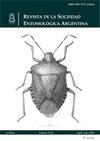角质层硬化前体N-β-丙酰多巴胺也参与黑腹果蝇幼虫趋光行为的调控。
IF 0.5
4区 农林科学
Q4 ENTOMOLOGY
引用次数: 0
摘要
趋光性是一种被充分研究的昆虫行为,被描述为刚性和刻板的。幼虫对光的反应可以通过快速和高度重复的实验来评估,如半暗/半亮板。黑腹果蝇(Drosophila melanogaster Meigen)(双翅目:果蝇科)突变体可用于研究幼虫对感官刺激的反应。黑檀木突变体的成人表现出行为缺陷,如昼夜节律异常和视力严重缺陷,而棕褐色突变体则表现出视力轻微缺陷。我们分析了黑腹夜蛾突变体幼虫对N-β-丙烯酰衍生物(黑檀和棕檀)代谢的反应,以确定它们是否也表现出异常的趋光行为。结果表明,黑檀木幼虫对光的反应具有随机性,而棕檀木幼虫对光的反应与野生型幼虫相似。为了评估N-β-丙烯酰衍生物代谢是否参与了幼虫对光的反应,我们给它们喂食N-β-丙烯酰多巴胺(NBAD)、N-β-丙烯酰组胺(致癌物质)和多巴胺。NBAD恢复了黑木幼体的wt反应,而致癌物和DA没有作用。这些结果首次表明NBAD可能作为一种神经活性化合物参与了黑腹天蛾幼虫的光致反应。本文章由计算机程序翻译,如有差异,请以英文原文为准。
Cuticle sclerotization precursor N-β-alanyldopamine also plays a role in the regulation of larval phototactic behaviour in Drosophila melanogaster (Diptera: Drosophilidae)
Phototaxis is a well-studied insect behaviour described as rigid and stereotyped. Larval response to light can be assessed by a fast and highly repetitive assay like a half-dark/half-illuminated plate. Drosophila melanogaster Meigen (Diptera: Drosophilidae) mutants can be used to study the response of larvae to sensory stimuli. Adults of the ebony mutant show behavioural deficits such as abnormal circadian rhythms and severe defects in vision, whereas the tan mutants show a slight deficiency in vision. We analysed the response of D. melanogaster mutant larvae for N-β-alanyl derivatives metabolism (ebony and tan) to determine whether they also show abnormal phototactic behaviour. Our results showed that ebony larvae exhibited a random response to light, whereas tan larvae showed a similar response to wild-type larvae. To assess if N-β-alanyl derivatives metabolism might be involved in the response of larvae to light, we fed them with N-β-alanyldopamine (NBAD), N-β-alanylhistamine (carcinine) or dopamine. NBAD restored the wt response in ebony larvae, whereas carcinine and DA produced no effect. These results suggest, for the first time, that NBAD might act as a neuroactive compound involved in the phototactic response of the D. melanogaster larvae.
求助全文
通过发布文献求助,成功后即可免费获取论文全文。
去求助
来源期刊

Revista De La Sociedad Entomologica Argentina
Agricultural and Biological Sciences-Insect Science
CiteScore
0.80
自引率
20.00%
发文量
31
审稿时长
20 weeks
 求助内容:
求助内容: 应助结果提醒方式:
应助结果提醒方式:


